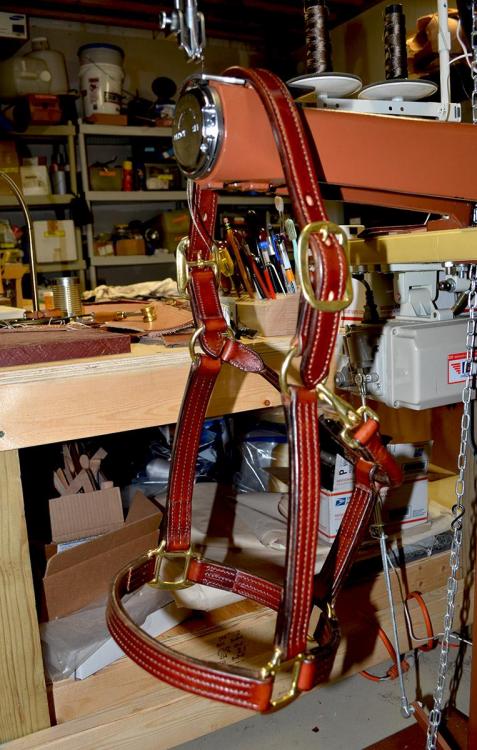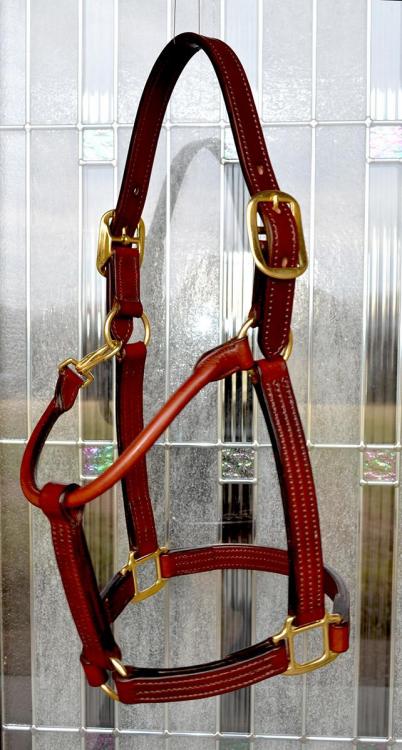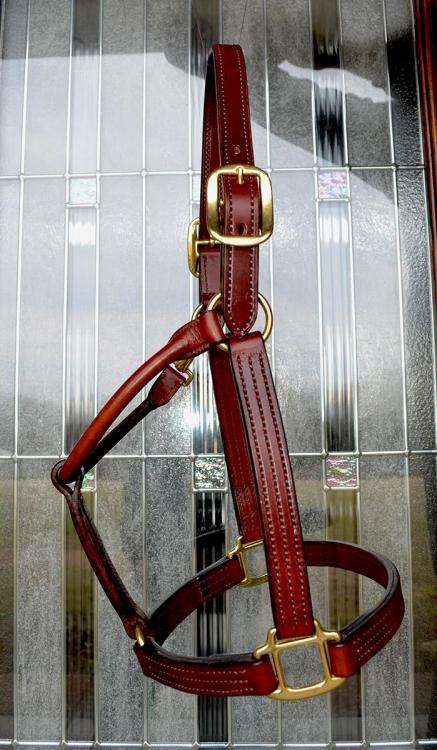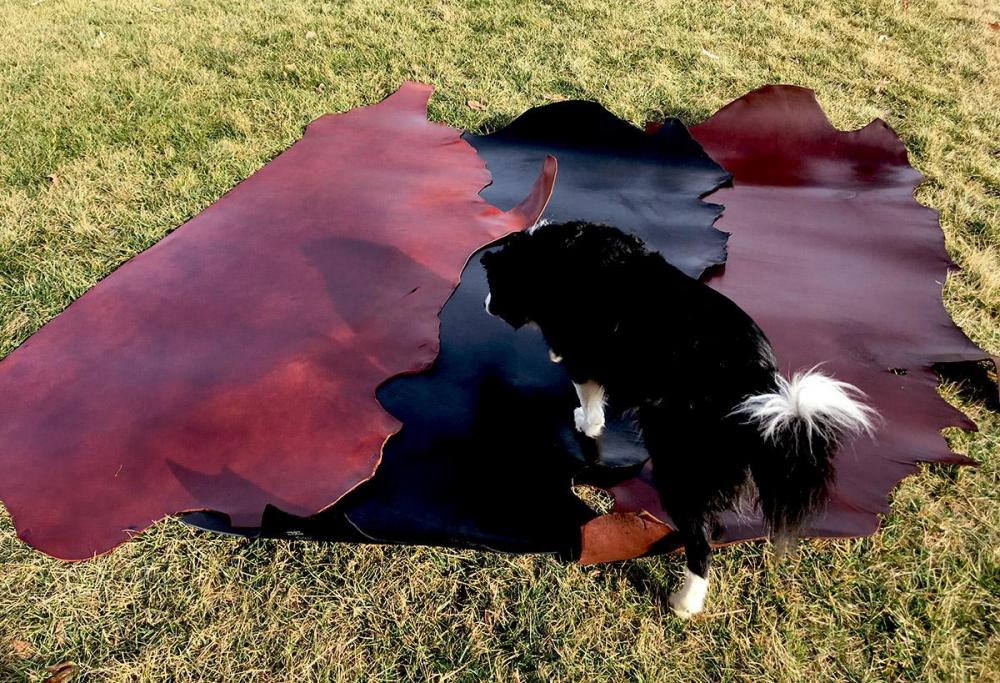-
Posts
1,282 -
Joined
-
Last visited
Content Type
Profiles
Forums
Events
Blogs
Gallery
Everything posted by TomE
-
This idea of a hole at the end of a cut is used in bridle headpieces. The "split" separates 2 points for attaching a noseband and bit to the bridle. It is common practice to punch a hole at the end of the split to prevent tearing of the leather. What usually happens instead is the point is torn at one of the buckle holes used to adjust the length of the noseband (cavesson) or the bit billet.
-
Wow that's a good fit. Lots of neat details.
-
Ha! No charge. Do you smooth out the wax after applying? I like using my fingers because it makes them a little tacky and I can grip the needles better. Other distinguished members of this forum using heavy brown paper to burnish the waxed thread.
-
My 2 cents as a retired biochemist. The notable ingredients of Fiebings Pro Dye - isopropanol, ethyl acetate, and xylene - are not highly toxic, and on par with paint thinner. Don’t drink it and avoid skin contact. It is flammable. Isopropanol is the disinfecting alcohol used in doctors offices. Xylene and ethyl acetate are solvents found on lots of home products. Can cause respiratory problems and skin irritation if you have high level exposure. I’d be more concerned about the fire hazard. These are all highly volatile and won’t leave a residue in the leather after the dye is dry. The pigments in these dyes are not disclosed, could be problematic, but are present in smaller amounts. Bottom line - keep away from flame, wear gloves (nitrile), and use in a well ventilated area.
-
I bought these #21 needles for my Class 4 but haven't yet tried them out. https://leathermachineco.com/product/794-s-needles-size-21/ I read that these are newly restocked and haven't been available for some time. @Patrick1 posted a video on FB recently showing a Class 4 sewing 2 oz deerskin with 92 thread and a #19 needle in system 794. Not sure where he got the needle.
-
Neat project. The blade appears to be positioned behind the top of the roller. Have you tried moving it closer to the centerline?
-
Not sure of your application -waxing thread? sealing leather? - but borax might not be leather friendly. It dissolves in water to form a solution with a pH > 9.0. Above 70 oC borax decomposes to unspecified compounds and gives off gases that are reportedly toxic. https://pubchem.ncbi.nlm.nih.gov/compound/Borax#section=Chemical-and-Physical-Properties
-
Thank you, @Bert03241, @Thescandall, and @PastorBob. I've stayed focused on halters, bridles, and reins for the past few years to work on the fundamentals of cutting and sewing leather. Now it's time to dig out my carving tools that I put away in the early 1970s when girls and cars became a distraction.
-
The supply chain has sorted itself out after almost 1 year, and I was able to buy more of my favorite brass hardware for halters. This is a late Christmas present for my co-worker. She and I are in the equine care and sanitation business. My prior administrative job prepared me well for shoveling horse$#it.
-
Was looking at the same site. That's where I buy sanding sleeves for my Cobra burnisher/sander. I think the bench grinder @Kovant picked out has a 5/8" shaft but I am uncertain about the thread size.
-
Sharpening and stropping an awl is a good excuse to have a cup of coffee (tea) and rest shoulders from pulling up stitches. The Osborne awl hafts feel good in my hand. I use the big peg awl haft with a new/thick awl blade for really heavy projects because it goes where I point it.
-
Stall mats in the US are typically 3/4 in. thick rubber with no fiber. They often have grooves or some texture on the bottom that could serve as tread for a sandal. They can be cut fairly easily in warm weather using a regular utility knife, although it takes me several passes with the knife. Helps to bend the rubber slightly away from from blade to relieve friction.
-
Always been happy with HO bridle sides. Consistent temper and minimal waste. These colors are British Brown, Black, and Havana. Truman has retinal degeneration and gradually lost his sight. He navigates surprisingly well by hearing and touch, helps with horse chores every day and follows me to my basement leather shop. He will howl if I leave him behind in the house.
-
Clever idea. This guy would be awesome help for replacing stall mats.
-
Picked out some HO bridle sides at Springfield Leather Company. Truman has selected his favorite color despite the fact that he's blind. Big thanks to @TonySFLDLTHR for his help with checking inventory yesterday and showing me a stack of beautiful sides when I visited the store today. Time to get busy and make sumpin'.
-
I was surprised to learn that the freezing point of pure acetic acid is 16 deg. Centigrade. https://www.sciencedirect.com/science/article/abs/pii/S016776750080041X#:~:text=properties of acetic acid.,point is %2B16.6 °C. Since vinegar is typically 4-8% acetic acid in water, the water actually lowers the freezing point.
-
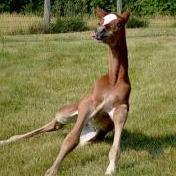
Made a thing: Sporran inspired hip bag
TomE replied to YinTx's topic in Purses, Wallets, Belts and Miscellaneous Pocket Items
Thanks. I am interested in different methods for this. I buy mostly bridle leather with a moss-back but if I split it then I will seal the backside. -

Made a thing: Sporran inspired hip bag
TomE replied to YinTx's topic in Purses, Wallets, Belts and Miscellaneous Pocket Items
Very handsome! How did you seal/burnish the flesh side of the flap? -
@TonySFLDLTHR, planning to call SLC tomorrow to check stock on HO bridle sides. 9-10 oz sides in black, London brown, and havana. Wanted to select 3 sides in person and I'm 3 hrs away from the store. Do you know about current stock?
-
Can sew between layers of leather using a holster plate if needed. See 58:30 min in this video from Chris Andre.
-
Yes, I like the weight of leather reins covered with the Equus grips. The rubber coated nylon web grips on these reins are lightweight and flexible (floppy), but they are a favorite of the owner. The cuff with a double row of stitches is the original. The cuffs I removed during the repair were falling apart so I replaced them with a thicker cuff. I could have incorporated the cuffs into the 2 stitch lines holding the leather straps on the grip webbing, but I decided to makes certain the straps were firmly attached to the grips before covering the ends with the cuffs.
- 2 replies
-
- bridle leather
- reins
-
(and 1 more)
Tagged with:
-
Pergamena tannery specializes in lighter weight veg tan leathers. https://www.pergamena.net/ They've been around a long time. See p. 10 of this newsletter. https://livestockconservancy.org/wp-content/uploads/2022/06/Summer-2022-Newsletter.pdf
-
Thanks, @jcuk. Foal slips seem likely since we’re in the business of producing foals. Still adding the side stitch to buckle turns and placing the fixed loop tight against the turn. I am trainable.
-
Batz Corp. Download their catalog for easy searching then search on part number for price.



